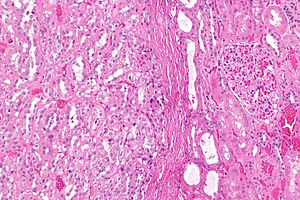Birt–Hogg–Dubé syndrome
Birt–Hogg–Dubé syndrome, also Hornstein-Birt-Hogg-Dubé syndrome,[1] is constellation of findings due to a FLCN (folliculin) gene mutation.[2] It is abbreviated BHD syndrome.
Features
BHD syndrome is characterized by:[3]
- Skin lesions:
- Fibrofolliculoma.
- Trichodiscoma.
- Acrochordon.
- Renal tumours:
- Variable penetrance (autosomal dominant).
Note:
- May be seen with a mix of oncocytic renal tumours - known as renal oncocytosis.
See also
References
- ↑ Happle, R. (Jun 2012). "Hornstein-Birt-Hogg-Dubé syndrome: a renaming and reconsideration.". Am J Med Genet A 158A (6): 1247-51. doi:10.1002/ajmg.a.35330. PMID 22581760.
- ↑ Online 'Mendelian Inheritance in Man' (OMIM) 135150
- ↑ Humphrey, Peter A; Dehner, Louis P; Pfeifer, John D (2008). The Washington Manual of Surgical Pathology (1st ed.). Lippincott Williams & Wilkins. pp. 290. ISBN 978-0781765275.
- ↑ Hes, O.; Petersson, F.; Kuroda, N.; Hora, M.; Michal, M. (Oct 2013). "Renal hybrid oncocytic/chromophobe tumors - a review.". Histol Histopathol 28 (10): 1257-64. PMID 23740406.

